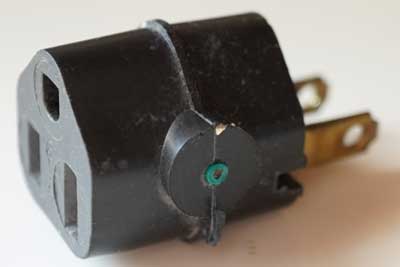 A
variation of the previous suggestion might be tried if one of the components has
a 3 prong plug. Use a ground lifter on that component and see if it helps.
A
variation of the previous suggestion might be tried if one of the components has
a 3 prong plug. Use a ground lifter on that component and see if it helps.YOU EXPERIENCE HUM WHEN CONNECTION TWO TURNTABLES TO A
PREAMP VIA THE LNS
OR
YOU EXPERIENCE HUM WHEN CONNECTION JUST ABOUT ANY DEVICE TO ANOTHER
A few facts about the Low Noise Switch (LNS). There are no connections between L & R shields (grounds) anywhere. Each input shield only connects to the corresponding internal Source 1 or Source 2 switches. The LNS chassis ground is not connected in any way to any of the input or output shields. This eliminates hum loops that usually occur when trying to use ordinary switches to connect two turntables to a preamp input.
One must connect the appropriate chassis ground of each turntable (Source 1 or Source 2) to the switch box, and run another from the switch box to the preamp being fed by the switchbox. There are variations that might be tried, such as, connect the chassis of each turntable to the preamp chassis and also the chassis of the switchbox to the earth of the preamp.
On rare occassions, hum problems can occur. This can be caused by some turntables being manufactured with its chassis body being connected to one of the output cable's shields. Some turntables have no separate ground wire connection and work fine with most preamps. Then again, some preamps may have one input channel shield connected to its chassis. So, some odd combinations may result in connecting the L & R shields external to the LNR
One solution could be reversing the power line plug polarity of one of the amps or the other, even both. Just pull the plug out turn it round and stick it back in.
 A
variation of the previous suggestion might be tried if one of the components has
a 3 prong plug. Use a ground lifter on that component and see if it helps.
A
variation of the previous suggestion might be tried if one of the components has
a 3 prong plug. Use a ground lifter on that component and see if it helps.
When totally baffled, I suggest, trying one turntable at a time to see if one
behaves differently to the other.
* Connect one turntable to Source 1.
* Connect Common to the preamp input.
* Connect the turntable ground to the SW ground and connect the SW ground to the
preamp ground.
Now, the above electrically represents almost no difference than connecting the
turntable directly to the preamp. The only circuit intervention is 4 electrical
contacts that connect the L, the R, the LG, and the RG. The earth connection of
the turntable directly connects to that of the Preamp. The chassis of the the SW
simply surrounds and shields the switches. There is no connection from the SW
earth to anything else. There should be no hum. If there is, something is
extremely bizarre. The below LAST RESORT has, so far, produced a
good result!
RCA CONNECTOR COMPATIBILITY- YES, THIS HAS HAPPENED!
Nowadays there are often mixtures of English and of Metric
connector parts. The simple RCA connectors can sometimes look connected, but are
not. To explain. Sometimes, the diameter of the shield connection of an RCA
connector may actually be a minute fraction of a mm larger than the ring of the
jack into which you are plugging. You will feel normal resistance when pushing
it in, but what you are feeling may simply be that of the center post
connecting. The shield may actually be held by that center post directly in the
middle and the shields are apart by that minute fraction of a mm. The fix is to
pull the plug out and squeeze the connector's shield. You may have to use pliers
to make that circle a tad oval. Then, when you plug it in, it will definitely
make a good ground connection.
A POSSIBLE LAST RESORT MOD FOR SOME SITUATIONS
This simple modification to the circuit board has proven to solve the worst hum problems. The situation has usually been when one or both of the turntables have the chassis ground connected to one of the signal cables' shield. Ditto, some cartridges will have their body shield connected to different channel shield pins.
Two short insulated wire leads of just about any gauge that is convenient can be used. Remove the 4 screws of the case bottom; and the 3 screws form Input1, Input 2 and Output RCA jacks. You will see the top of the printed circuit board (PCB). Remove the 2 screws holding down the PCB. Solder on the two short wire leads. Reassemble all.

HOW ABOUT ONE TURNTABLE TO TWO AMPS?